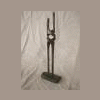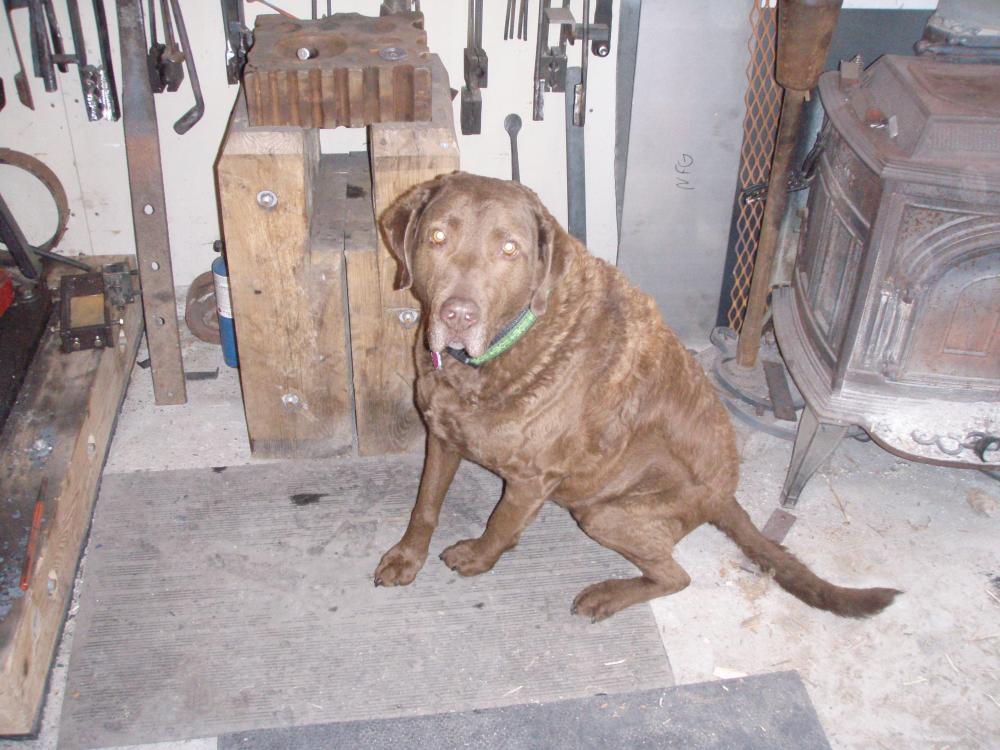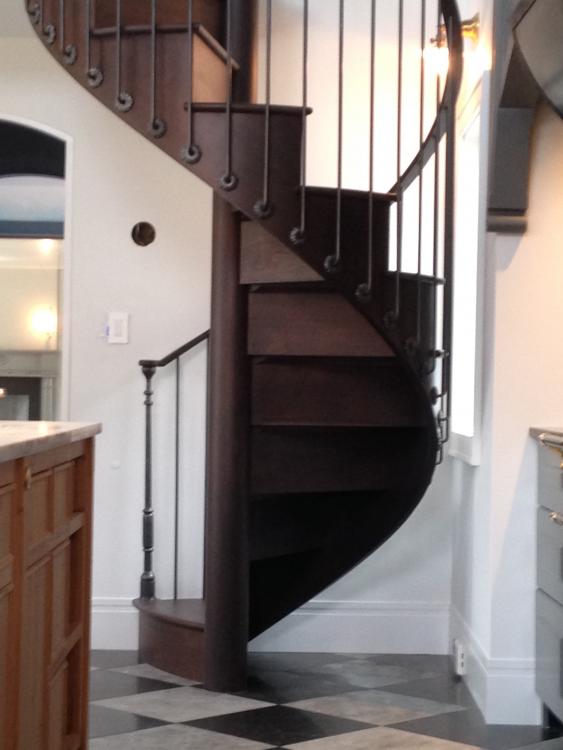-
Posts
1,804 -
Joined
-
Last visited
Content Type
Profiles
Forums
Articles
Gallery
Downloads
Events
Everything posted by Judson Yaggy
-
Save the date. Sept. 15-17, Goshen CT. More information to follow.
-
Posted this here before but was lost in the Great Photo Purges of IFI. Ignore the dog, the poor old fellow is long gone. Was a good dog. White oak timbers, 4 @8"x8"x whatever hight brings the block working surface up to anvil hight, thru bolted with allthread. Rabbit (slot) allows edges to be at same elevation. Top 1/2" of wood is routed out to contain the SwBloc .
-

New assembly table build. Could use help.
Judson Yaggy replied to Millhand's topic in Tools, general discussion
My 4x8 table is 3/4" plate supported and welded on a tight grid of 4x6x3/8" angle iron. After 6 years of heavy use, it has a slight upward bow/warpage from heat. Go with the biggest, thickest plate you can afford. My next table will be at least 1" thick (if I don't buy a platen table). A welding table in a blacksmith shop is not just for welding. I use mine for flatening and straightening large pieces, a base for large bending and scrolling jigs, support for hot fit asemblies, etc. If you are doing big projects or any level of professional work, go thick.- 5 replies
-
- yaoldbuzzerds
- lol
-
(and 1 more)
Tagged with:
-

Just picked up this beauty!!
Judson Yaggy replied to Jason gardener's topic in Anvils, Swage Blocks, and Mandrels
I have heard that you should ask for a penny in exchange for a gifted knife. Here in New England we have similar but slightly divergent and somewhat more diverse folklore. Personally I like T Of N's explanation. -
Armitage Mouse Hole if you hadn't already figured it out. Good score, should fit into 19th c USA replica shops just fine. Where you located?
-

Help with id'ing new anvil?
Judson Yaggy replied to corso21's topic in Anvils, Swage Blocks, and Mandrels
Looks like it's had a lot of welding done to the face. Look at the top view picture. -

cant find an anvil
Judson Yaggy replied to Viking Hammer's topic in TPAAAT - Applied Anvil Acquisition Technique
I bet Anglee ships to SA. -

Peter Wright copy/false stamp?
Judson Yaggy replied to Hairy_eyeball's topic in Anvils, Swage Blocks, and Mandrels
Not a fake stamp. Right kind of spacing, serrifs on the letters, old damage on top of the older letters, etc. It's an older anvil but not unique or collectors item especially with the damage. Congrats, its a user! Now start using it!- 12 replies
-
- falsified stamp
- barn rescue
-
(and 1 more)
Tagged with:
-
In the residential field, we call it "picking up the architect and carrying him to the finish line". It's not unheard of in this market for an architect or design firm to be fired by the client while retaining the GC. Different from commercial work thou, we tend to have simpler projects with more control exerted by the clients.
-
Stunning anvil. You are not driving over to the seller's place right now why?
-
Is it magnetic?
-
I agree. Mild steel, I'd prefer to chuck a worn one in the scrap bin than smack my dies into a cold piece of high carbon or alloy.
-
Worth? What you paid for it. From where I sit? I have several good anvils, so it looks small and broken to me. If II didn't have an anvil already, it woud be worth gold because it's fairly functional and I could use it to make money and then upgrade. You going to use it or flip it? As a user it's got the value you want to put into it. As a seller you need to find someone who will use it and sees past the damage to the potential. Get hammering on it and you will be happy!
-

How to keep wide flat stock flat
Judson Yaggy replied to Donniev's topic in Blacksmithing, General Discussion
Flat stock will do any or all of 3 things. Bend the easy way, bend the hard way, or twist (which is technically a combination of the first 2). To fix the bends, flip it over and hammer down on the high spot of the bend. To fix a twist clamp one end in a vise, sight the length, and muscle a bending fork, twisting wrench, tongs, adjustable wrench, etc the opposite way. Combination bend/twists are easier to fix if you correct the twist first. It is possible to hammer out a twist but it's more trouble than it's worth if you have a vise. Cold twisting tip: Scale pops off cold mild steel at around the same time you pass the yeild strength. Often when you see the scale start to jump off a bar it will have taken a new "set" and stay where you put it. YMMV In my opinion a swaybacked anvil is fine for hobby work but inferior for high quality professional work. You can straighten a bar on a flat anvil as easily as you can on a swaybacked one, but a flat anvil also allows the smith to instantly index the work piece to a flat surface, even the zone that would be up in the air on a swayback. No wasted steps to a secondary flat work surface or "eyeballing" while the piece cools. Energy costs money. 99% of the professional smiths I know or have seen working have a dead flat primary working surface. -
Good stuff Beevs, I totally agree with your premise. They tried to teach me trigonometry in high school and I said to myself "When am I ever going to use this?" I passed the class but not by much. A few years later I built my first house with a gable dormer on the roof. Suddenly it clicked, all that math had a real world application. In college the professors hammered the point home, math is the real language of the world. Design something, machine something, build or fabricate something, if you can do the math to model it or figure it out quicker than the competition, you win. If anyone out there wants to make money building a spiral stair, open a calculus textbook and think about curves.
-
I agree with John N. Not a particularly complicated or proprietary product. Manufacturing back in the USA? Great. That said it looks like a fab job with a cast ring on the top. Good luck to the OP, my first job out of college was as a draftsman/part number chaser who was tasked with reproducing badly documented products designed by someone who had left the company x years ago. So I feel your pain. Frosty, as a New Englander I find nothing wrong with his syntax aside from typos and that xxxx autocorrect. After all we have a BIG WIDE language. Also, I have noticed in the last few weeks the automatic spell chech here on IFI has stopped workingdr. Problematics for those of us whoo've aleays struggled with spelling even in outs fiorst langueage.
-
JHCC, Streeter's book has poor photographs and overly wordy descriptions, but there is GOLD in there if you can parse it. Keep that one.
-

Canedy Otto post drill no.3
Judson Yaggy replied to JT's topic in Drills, Post drills, Mag drills, etc
Here you go. Old catalog and it included parts breakdowns. canedy.pdf -
Great story, and bounus points for both good marketing AND introducing folks first hand to blacksithing! LB, if I recall you are a follower of the Brian B heavy hammer way of forging? Please excuse me if I'm incorrect. But you may want to think about having a lighter hammer (1.5 to 2 pounds) around to give to absolute beginners and those of lighter stature. I'm not trying to be down on that style, it's a great way for many people to forge. Just saying one size does not fit all. If she wasn't hitting hard with a big hammer moving slow, try a light hammer moving fast, and vice versa. Of course practice practice practice makes any hammer work well, but I've found that beginners get less frustrated when their arms are not tired.
-

Historical Blacksmith's tools
Judson Yaggy replied to ThomasPowers's topic in Blacksmithing, General Discussion
I had no idea blue spray paint was period correct for the Norse. Good to know! (grin) -
9=90 pounds. Put it on a bathroom scale to verify.
-
True. Also often true but not always the case, I think there were exceptions to this behavior. My hypothesis is that our (USA) industrial iron age peaked along with the acceleration of manufacturing technology. We didn't need a 9" wide leg vise and a crew of workers to hit it with sledge hammers because suddenly there were other options for a given manufacturing process. Who needs a big ass vise when the guy in the next factory over has a punch press and a pneumatic upsetter? The Brits and Germans entered this game earlier in the global evolution of tech so you see more "big" hand tools surviving from that part of the world just because they used them for longer. Some big hand tools were made and used here in America too, they were just superseded sooner. The exceptions to my suggestion above comes from the geographic size and diversity of the USA, and the specialization in regional manufacturing. Some places due to remote location (the USA is a BIG place) or lucky location on the time/technology curve did need big hand tools. If you are very lucky you can still find some of those tools today.


